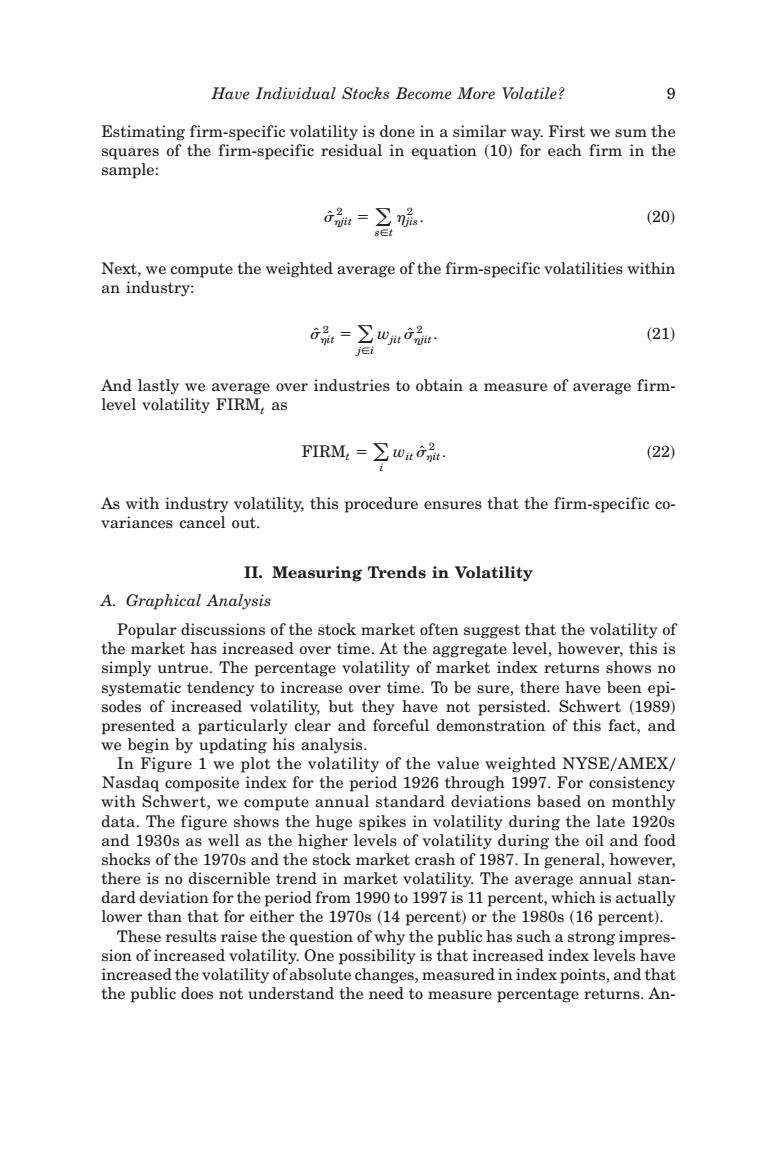正在加载图片...

Have Individual Stocks Become More Volatile? 9 Estimating firm-specific volatility is done in a similar way.First we sum the squares of the firm-specific residual in equation (10)for each firm in the sample: 品=∑n品 (20) 8后t Next,we compute the weighted average of the firm-specific volatilities within an industry: 品=∑w品t· (21) jEi And lastly we average over industries to obtain a measure of average firm- level volatility FIRM,as FIRM=∑wuG品. (22) As with industry volatility,this procedure ensures that the firm-specific co- variances cancel out. II.Measuring Trends in Volatility A.Graphical Analysis Popular discussions of the stock market often suggest that the volatility of the market has increased over time.At the aggregate level,however,this is simply untrue.The percentage volatility of market index returns shows no systematic tendency to increase over time.To be sure,there have been epi- sodes of increased volatility,but they have not persisted.Schwert (1989) presented a particularly clear and forceful demonstration of this fact,and we begin by updating his analysis. In Figure 1 we plot the volatility of the value weighted NYSE/AMEX/ Nasdag composite index for the period 1926 through 1997.For consistency with Schwert,we compute annual standard deviations based on monthly data.The figure shows the huge spikes in volatility during the late 1920s and 1930s as well as the higher levels of volatility during the oil and food shocks of the 1970s and the stock market crash of 1987.In general,however, there is no discernible trend in market volatility.The average annual stan- dard deviation for the period from 1990 to 1997 is 11 percent,which is actually lower than that for either the 1970s(14 percent)or the 1980s(16 percent). These results raise the question of why the public has such a strong impres- sion of increased volatility.One possibility is that increased index levels have increased the volatility ofabsolute changes,measured in index points,and that the public does not understand the need to measure percentage returns.An-Estimating firm-specific volatility is done in a similar way. First we sum the squares of the firm-specific residual in equation ~10! for each firm in the sample: s[ hjit 2 5 (s[t hjis 2 . ~20! Next, we compute the weighted average of the firm-specific volatilities within an industry: s[ hit 2 5 ( j[i wjit s[ hjit 2 . ~21! And lastly we average over industries to obtain a measure of average firmlevel volatility FIRMt as FIRMt 5 ( i wit s[ hit 2 . ~22! As with industry volatility, this procedure ensures that the firm-specific covariances cancel out. II. Measuring Trends in Volatility A. Graphical Analysis Popular discussions of the stock market often suggest that the volatility of the market has increased over time. At the aggregate level, however, this is simply untrue. The percentage volatility of market index returns shows no systematic tendency to increase over time. To be sure, there have been episodes of increased volatility, but they have not persisted. Schwert ~1989! presented a particularly clear and forceful demonstration of this fact, and we begin by updating his analysis. In Figure 1 we plot the volatility of the value weighted NYSE0AMEX0 Nasdaq composite index for the period 1926 through 1997. For consistency with Schwert, we compute annual standard deviations based on monthly data. The figure shows the huge spikes in volatility during the late 1920s and 1930s as well as the higher levels of volatility during the oil and food shocks of the 1970s and the stock market crash of 1987. In general, however, there is no discernible trend in market volatility. The average annual standard deviation for the period from 1990 to 1997 is 11 percent, which is actually lower than that for either the 1970s ~14 percent! or the 1980s ~16 percent!. These results raise the question of why the public has such a strong impression of increased volatility. One possibility is that increased index levels have increased the volatility of absolute changes, measured in index points, and that the public does not understand the need to measure percentage returns. AnHave Individual Stocks Become More Volatile? 9